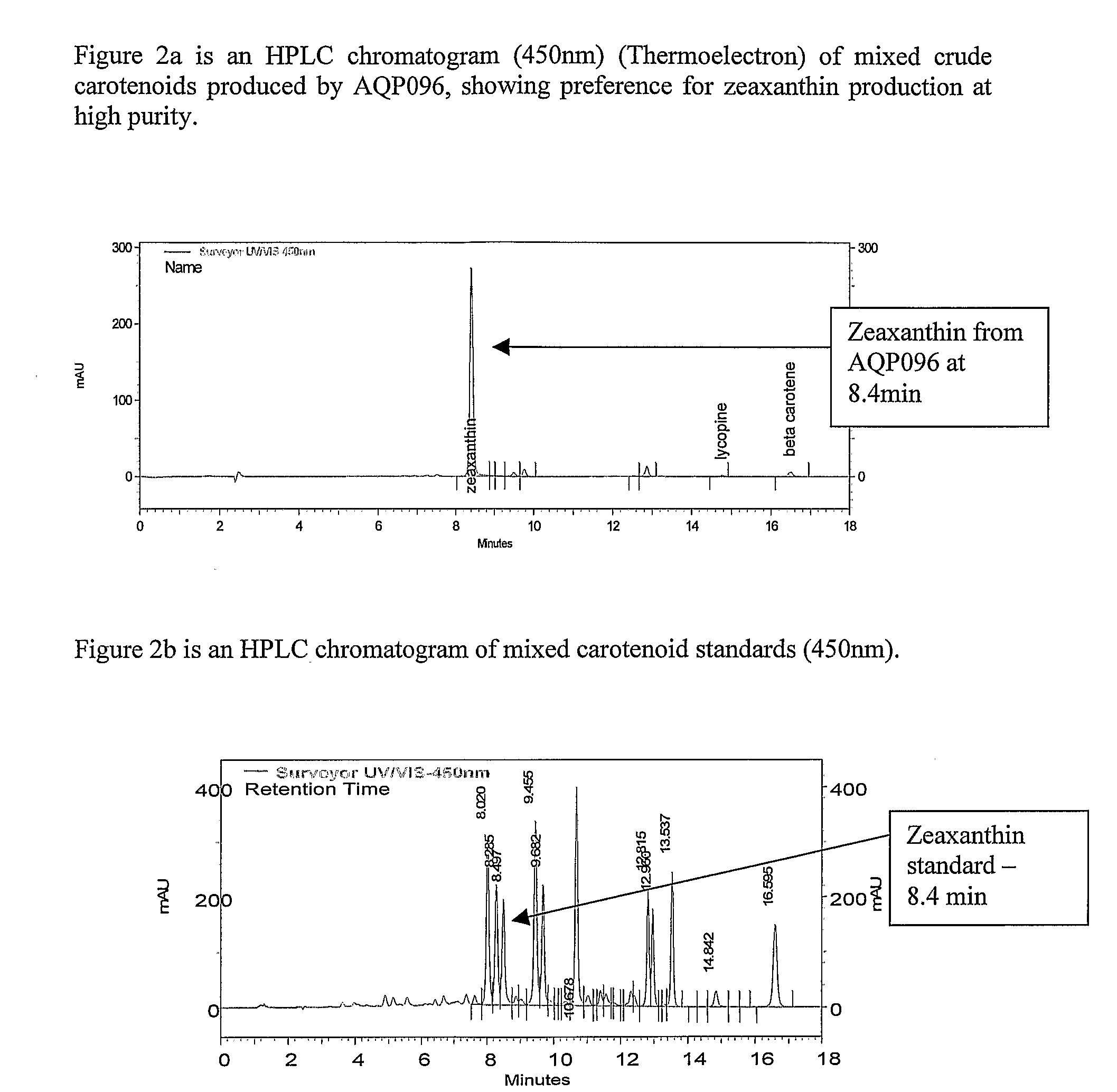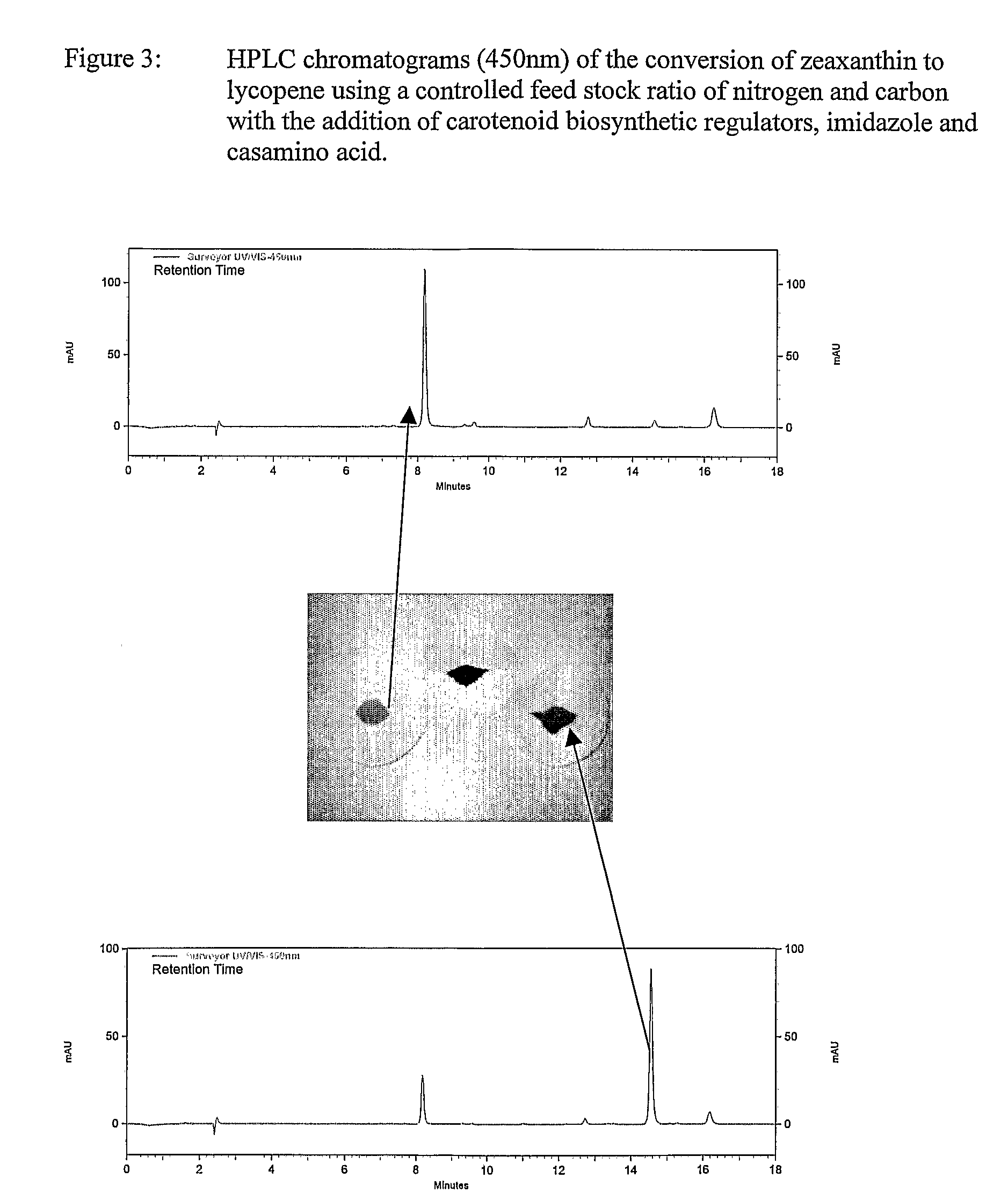Biological Production of Zeaxanthin and Carotenoid Biosynthesis Control
a technology of biosynthesis control and zeaxanthin, which is applied in the field of carotenoids isolating, can solve the problems of biological availability and instability, and achieve the effect of promoting a pharmacological or physiological
- Summary
- Abstract
- Description
- Claims
- Application Information
AI Technical Summary
Benefits of technology
Problems solved by technology
Method used
Image
Examples
example 1
Isolation of Algibacter sp. nov Strain AQP096 NCIMB 41268
[0056]Seawater samples was collected from several shallow water locations for locating bacteria. 100 ul of seawater were plated out onto Difco Marine Agar 2216E. The agar plates were incubated for 7 days in laboratory ambient conditions (approx 21° C.).
[0057]Colonies that displayed shades of yellow, red and orange were sub-cultured and purified resulting in the isolation of particular strains. One of these strains that displayed an yellow-orange shade was chosen (named AQP096) and has been deposited at NCIMB under accession number NCIMB 41268.
[0058]Strain AQP096 exhibited a strong yellow-orange pigment on agar medium and when cultured in marine broth produced yellow-orange pigments. The microorganisms are Gram negative rods. The yellow / orange pigment extracted from Algibacter sp. AQP096 produced a similar absorption spectra and chromatographic retention time to that reported for zeaxanthin as its major pigment (98%).
[0059]On t...
example 2
Cultivation of Algibacter sp. nov and Quantification of Zeaxanthin Production
[0062]The liquid medium has the following composition per L of broth
compositiong / lYeast Extract45Glucose33Phosphate Sulphate2.5Fat source100 μL / mlCarotenoid biosynthesis regulators*20 mMOLSea waterremainder
[0063]This nutrient medium was adjusted to a pH of 7.5 using a 1M sodium hydroxide (NaOH) solution. The growth conditions for the inoculated cultures at 25° C., pH7.5, for 2 days with continuous aeration. Aeration was provided by shaking at 200 rpm using 25 ml shake Erlenmeyer flask culture.
[0064]To extract pigment from Algibacter sp, the cell pellet was freeze dried and then resuspended in 100 μl of lysozyme lysis buffer (50 mmol / l Tris, 200 mmol / l NaCl and 0.2 g / l lysozyme, adjusted to pH 7.5 using 1M HCl) in a microcentrifuge tube and left for 45 min in the dark.
[0065]A solution of tetrahydrofuran containing 0.05% w / v BHT was prepared and 500 μl was added to the resuspended biomass. This mixture was l...
example 3
Optimisation of Culture Conditions
[0075]The following experiment determines the best set of culture conditions for optimised production of microbial biomass from fermentation of Algibacter sp. Media as described in Table 3 were formulated, autoclaved, cooled and inoculated with a strain of Algibacter. All pHs were maintained at 7.5 and cell yields were calculated by centrifugation 4,500 rpm for 20 min, decanting the liquor and freeze drying the cell pellet.
TABLE 3Comparison of culture media in g / L composition used in the biomassoptimisation of Algibacter sp. AQP096Mediaa (g / L)b (G / L)c (G / L)d (G / L)e (G / L)f (G / L)Glucose11331Peptone5Yeast Extract1554515TSB30Vegetable oil100μL / mlImidazole20mMolMendadione100μg / mlLipase0.05ml / LPhosphate2.52.52.5Na Acetate0.1ml / LNatural sea water1L1L1L1L1L1L
The results are shown in table 4:
TABLE 4Overview of the data of biomass optimisation of the Algibacter sp.AQP096 wild type and mutant strain at 5L fermentation.mg / g drycdwlARGESTCAROTENOIDPURITY OFweigh...
PUM
| Property | Measurement | Unit |
|---|---|---|
| flow rate | aaaaa | aaaaa |
| pH | aaaaa | aaaaa |
| volumes | aaaaa | aaaaa |
Abstract
Description
Claims
Application Information
 Login to View More
Login to View More - R&D
- Intellectual Property
- Life Sciences
- Materials
- Tech Scout
- Unparalleled Data Quality
- Higher Quality Content
- 60% Fewer Hallucinations
Browse by: Latest US Patents, China's latest patents, Technical Efficacy Thesaurus, Application Domain, Technology Topic, Popular Technical Reports.
© 2025 PatSnap. All rights reserved.Legal|Privacy policy|Modern Slavery Act Transparency Statement|Sitemap|About US| Contact US: help@patsnap.com



